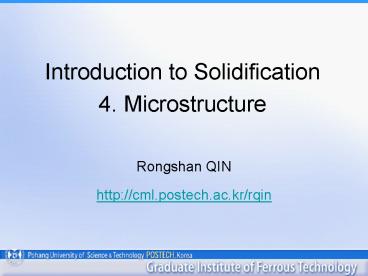Introduction to Solidification 4. Microstructure PowerPoint PPT Presentation
1 / 24
Title: Introduction to Solidification 4. Microstructure
1
Introduction to Solidification4. Microstructure
- Rongshan QIN
- http//cml.postech.ac.kr/rqin
1
2
Casting ductile iron cylinders http//www.mse.mtu
.edu/casting_iron/casting_iron.html
3
Microstructure of ingots
T. F. Brower and M.C. Flemings, Trans. AIME, 239,
1620 (1967)
4
Phase-field simulation of casting
H.B. Dong and P.D. Lee, Acta Mater. 53 (2005) 659
5
Outer chilled zones
6
Outer chilled zones
7
Outer chilled zones
8
Outer chilled zones
Pure metals Formation of shell because
temperature gradient is the key factor in grain
growth.
9
Outer chilled zones
Alloy solutions Growth is determined by
temperature gradient as well as constitutional
supercooling.
10
Outer chilled zones
T
liquidus
solidus
c
11
Outer chilled zones
Pouring temperature
re-melted?
survived?
12
Microstructure of ingot
- Chilled zone
- Fine equiaxed grains.
- Pure substance Continuous shell.
- Solution Particles
- Particles flushed away from wall into the central
- Re-melted
- Survived nucleus
13
Intermediate columnar zone
The grain is overtaken by neighbors.
Columnar grains grows
14
Intermediate columnar zone
Growth and overtaken
15
Intermediate columnar zone
Columnar growth blocked
16
Intermediate columnar zone
Supercooling and interfacial energy Curvature and
interface kinetic coefficient.
Formation of dendrite
17
Intermediate columnar zone
18
Intermediate columnar zone
Bridging of secondary arms
19
Intermediate columnar zone
Root melting and dendrite fragments
20
Central equiaxed zone
- Equiaxed grain
- Nucleation
- Supercooling
- Falling particles
- Dendrite fragments
- Elevated pouring temperature
- Larger equiaxed grains
21
Structure and properties
- More columnar zone
- Anisotropic properties
- Magnetic materials
- Turbo blade.
- More equiaxed zone
- Isotropic properties
- Less segregation
22
Microstructure and processing
- materials
- composition
- nucleation ability
- mold
- thermal conductivity, specific heat
- casting condition
- pouring temperature
- convection.
23
In summary
- Three microstructure zones
- Outer chilled zone
- Intermediate columnar zone
- Central equiaxed zones
- Microstructure control
24
References
- T. F. Brower and M.C. Flemings, Trans. AIME, 239,
1620 (1967). - H.B. Dong and P.D. Lee, Acta Mater. 53 (2005)
659. - W.J. Boettinger, et al., Annual Review of
Materials Research 32 (2002) 163.

